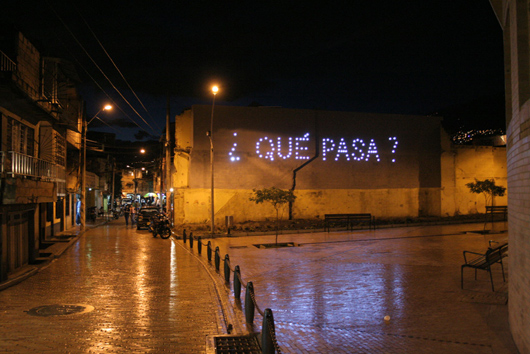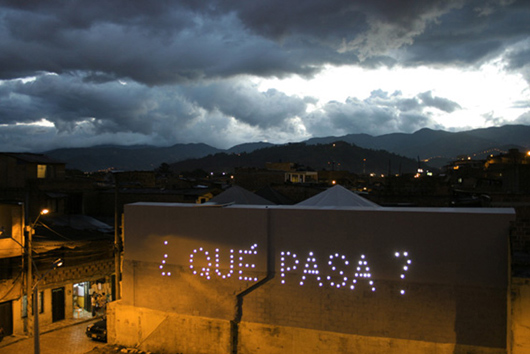¿que pasa? – medellin – colombia
• 4485 Views • No hay comentarios en ¿que pasa? – medellin – colombia
A project that works with memory and art to anticipate urban and social transfomations.
An installation to reflect on changes and energy abuse. An always open question. 
Moravia is the district of Medellin periphery built on the landfill. Seven thousand viviendas climbing the hill, brick, wood, cardboard, accumulated since Sixties.
Between Eighties and Nineties, when the city had the sad primacy of drug trafficking capital among the most violent and dangerous of the world, Moravia was one of the most problematic urban areas, where the serious social and sanitary problems were compounded by those related to crime and public order.
The Medellin rebirth based on culture, education, rehabilitation of degraded situations led by Mayor Fajardo, in the last five years has also produced results in this quarter, trying to offer alternatives to poverty and exclusion.
Metrocable, the transport system made with Colombian technology, has given accessibility to the area, making it part of urban fabric and the Macroproyecto de Moravia has been developed to promote sustainable development with actions of urban regeneration and improvement of environmental,socio-cultural and socio-economic conditions.
To this end the Macroproyecto works on both physical and social components as the public space, hygiene, housing, education. Sign of change is also the Centro de Desarrollo Cultural de Moravia (CDCM), wanted by the community and designed by the Colombian architect Rogelio Salmona as a space for culture and education, music, art, cinema, theater.
“Lo que importa es que la cultura sea realmente cultivada”.
The Macroproyecto has also led to the demolition of the barracks and the transfer of population in new housing, starting an attempt to regularize use and occupation of ground.
The CDCM promoted the initiative to redevelop the places recovered with artistic interventions on the walls left empty by the dismantling of the huts.
The first realized is a project of demolition and reconstruction, according to the barrio logic of continuous self-made, which has directly involved the community to write “¿Que Pasa?” with leds powered by solar panels. With the night the sentence lights . The solar energy accumulated during the day makes it illuminate for eight-nine hours.
The image recalls the lights of the houses that were lit every day on the same wall and drew, in a match totally not calculated, the landscape of the city.
¿Que Pasa? is a permanent public installation of the artist Katia Meneghini, a project curated by Alejandro Vásquez and supported by the Centro de Desarrollo Cultural de Moravia in collaboration with Cittadelarte-Fondazione Pistoletto and Festival della Creatività in Florence. Every day the phrase creates a place of aggregation, a meditation space for people who live and are part of changes. One way to give to the community greater awareness and responsibility in social change and enhance the cultural memory of the barrio and spaces for community organization, still too weak in suburbs and slums.

Related Posts
« Croquis Maestros: El Trazo Artesanal de Carlo Scarpa y Una Deuda Impostergable Mappa Partecipativa per il terremoto »

 Technorati
Technorati Flickr
Flickr del.icio.us
del.icio.us Ice Rocket
Ice Rocket Wikipedia
Wikipedia
